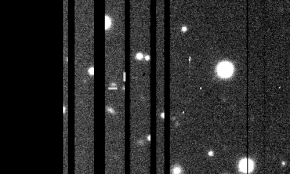
Back Autonoe (Mond) ALS أوتوني (قمر) Arabic Аўтаное (спадарожнік) Byelorussian Автоноя (спътник) Bulgarian অতনয় (উপগ্রহ) Bengali/Bangla Autonoe (loarenn) Breton Autònoe (satèl·lit) Catalan Autonoe (ôi-sĭng) CDO Autonoe (měsíc) Czech Autonoe (måne) Danish
 Discovery images of Autonoe by the Canada-France-Hawaii Telescope in December 2001 | |
| Discovery[1] | |
|---|---|
| Discovered by | Scott S. Sheppard et al. |
| Discovery site | Mauna Kea Obs. |
| Discovery date | 10 December 2001 |
| Designations | |
Designation | Jupiter XXVIII |
| Pronunciation | /ɔːˈtɒnoʊ.iː/[2] |
Named after | Αυτονόη Aytonoē |
| S/2001 J 1 | |
| Adjectives | Autonoean /ˌɔːtənoʊˈiːən/ |
| Orbital characteristics [3] | |
| 23039000 km | |
| Eccentricity | 0.334 |
| −719.01 days[4] | |
| Inclination | 152.9° |
| Satellite of | Jupiter |
| Group | Pasiphae group |
| Physical characteristics | |
| 4 km | |
Spectral type | B–V = 0.72 ± 0.03, V–R = 0.51 ± 0.02[5] |
| 22.0 | |
| 15.5[4] | |
Autonoe /ɔːˈtɒnoʊ.iː/, also known as Jupiter XXVIII, is a natural satellite of Jupiter.
Autonoe was discovered by a team of astronomers from the University of Hawaii led by Scott S. Sheppard in 2001, and given the temporary designation S/2001 J 1.[6][1][7]
Autonoe is about 4 kilometres in diameter, and orbits Jupiter at an average distance of 24,264,000 km in 719.01 days. It orbits at an inclination of 151° to the ecliptic (150° to Jupiter's equator) in a retrograde direction and with an eccentricity of 0.369.
It belongs to the Pasiphae group, irregular retrograde moons orbiting Jupiter at distances ranging between 22.8 and 24.1 Gm, and with inclinations ranging between 144.5° and 158.3°.
Autonoe was named in August 2003 after the Greek mythological figure Autonoë, conquest of Zeus (Jupiter),[8] mother of the Charites (Gracies), according to some authors.[9]
- ^ a b MPEC 2002-J54: Eleven New Satellites of Jupiter 2002 May 15 (discovery and ephemeris)
- ^ Noah Webster (1884) A Practical Dictionary of the English Language
- ^ S.S. Sheppard (2019), Moons of Jupiter, Carnegie Science, on line
- ^ a b Cite error: The named reference
MPC115890was invoked but never defined (see the help page). - ^ Cite error: The named reference
GraykowskiJewitt2018was invoked but never defined (see the help page). - ^ IAUC 7900: Satellites of Jupiter 2002 May 16 (discovery)
- ^ MPEC 2002-V03: S/2001 J 1 2002 November 1 (revised ephemeris)
- ^ IAU Website: Satellites of Jupiter, Saturn and Uranus Archived October 12, 2007, at the Wayback Machine
- ^ USGS Astrogeology: Gazetteer of Planetary Nomenclature - Planetary Body Names and Discoverers